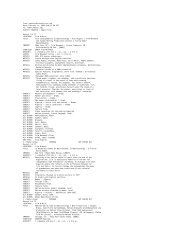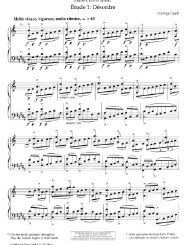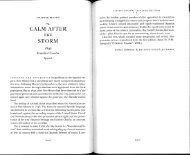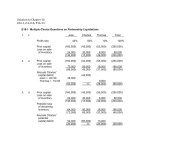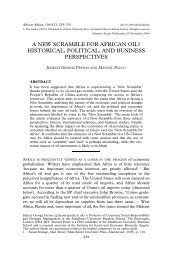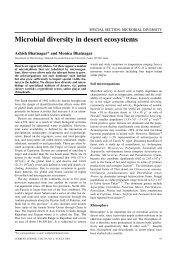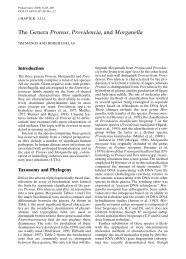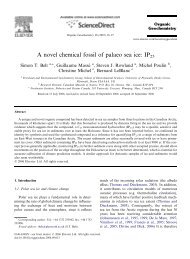Analysis by Key: Another Look at Modulation
Analysis by Key: Another Look at Modulation
Analysis by Key: Another Look at Modulation
You also want an ePaper? Increase the reach of your titles
YUMPU automatically turns print PDFs into web optimized ePapers that Google loves.
CCARI SCHACHTER<br />
example, th<strong>at</strong> the first solo in the second movement of the Beethoven Fourth<br />
Concerto does not contain a modul<strong>at</strong>ion to A minor. Still, one can feel (and I<br />
certainly do) th<strong>at</strong> reading new keys <strong>at</strong> such places is destructive of good analysis<br />
in th<strong>at</strong> it isol<strong>at</strong>es details and blurs significant differences. Schenker is certainly<br />
right in criticizing analyses th<strong>at</strong> contain an 'absurd abundance of keys',<br />
impossible though it is to determine just where an abundance begins to be<br />
absurd.<br />
Between brief toniciz<strong>at</strong>ions and large-scale, generously ramified 'keys', one<br />
might distinguish a few important c<strong>at</strong>egories. There are 'keys', for example,<br />
with full harmonic cadences, but without melodic closure. There are others th<strong>at</strong><br />
have an initial 'tonic' but th<strong>at</strong> end with a dividing dominant harmony. There are<br />
still others th<strong>at</strong> lead through wh<strong>at</strong> Schenker calls an 'auxiliary cadence' to a<br />
closing tonic; often these lack an opening tonic.<br />
Among the most curious cases are those 'keys' whose tonics never arrive, as in<br />
the Schubert excerpt of Ex. 6; these, if any, are 'illusory keys of the foreground'.<br />
Sometimes, however, such 'keys' can play quite a significant role in the<br />
design of a piece. In the first movement of Mendelssohn's String Quartet in E<br />
minor (Op. 44, No. 2), the second part of the exposition is in a G ma jor (III) th<strong>at</strong><br />
follows 14 bars (!) of wh<strong>at</strong> seems to be a prolonged V of B minor, so th<strong>at</strong> the<br />
initial impression is V-VI in th<strong>at</strong> key. Rel<strong>at</strong>ed deceptive cadences occur <strong>at</strong> two<br />
significant junctures l<strong>at</strong>er on in the movement, before the recapitul<strong>at</strong>ion and in<br />
the coda; these, however, are followed eventually <strong>by</strong> the appearance of the tonic<br />
initially expected (both times the main E minor tonic of the movement),<br />
producing a very special sense of large-scale resolution.30<br />
A Sample <strong>Analysis</strong><br />
Cherubino's Arietta 'Voi che sapete', from Act 2 of Le nozze di Figaro, provides<br />
an appropri<strong>at</strong>e final example for this study. The second section of its ABA<br />
design contrasts very little in rhythm and texture with the simple first seciion<br />
and its modified da capo; the represent<strong>at</strong>ion in the orchestra of Susanna's<br />
accompanying guitar requires a certain uniformity. Tonally, however, the two<br />
seciions could hardly differ more, for the second, after a straightforward<br />
beginning in the dominant key, moves suddenly into areas whose connection to<br />
each other and to the BW di<strong>at</strong>ony of the whole is difficult to understand.<br />
The problem centres on bs 37-52, which contain a fully tonicized AW major<br />
(37-44) including a ca(lential bass and melodic closure on AW . Following the<br />
phrase in AW is a modul<strong>at</strong>ory part th<strong>at</strong> culmin<strong>at</strong>es in a G minor cadence (b. 52);<br />
the rel<strong>at</strong>ion of this G minor to wh<strong>at</strong> precedes and follows it is far from obvious.<br />
The problem<strong>at</strong>ic n<strong>at</strong>ure of this passage did not escape the notice of Schoenberg,<br />
who discusses the aria briefly in Chapter IX of Structural Functions. Schoenberg<br />
reads the AW as W MD (dominant of the fl<strong>at</strong> mediant) and points to Beethoven's<br />
use of the same region in the opening themes of his Piano Son<strong>at</strong>as, Opp. 31,<br />
No. 1 and 53. Because the region is so uncharacteristic of Mozart, and because<br />
308<br />
MUSIC ANALYSIS 6: 3, 1987



